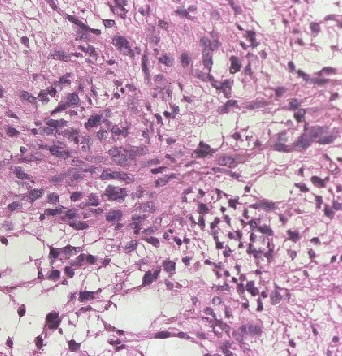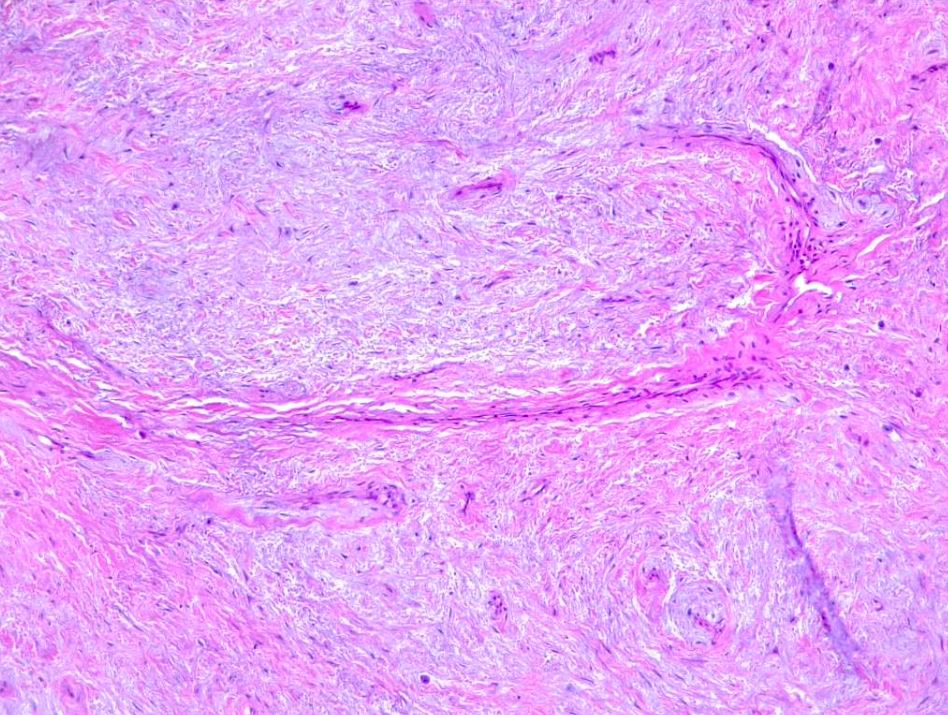[1]
Jo VY,Fletcher CD, WHO classification of soft tissue tumours: an update based on the 2013 (4th) edition. Pathology. 2014 Feb;
[PubMed PMID: 24378391]
[3]
Augsburger D,Nelson PJ,Kalinski T,Udelnow A,Knösel T,Hofstetter M,Qin JW,Wang Y,Gupta AS,Bonifatius S,Li M,Bruns CJ,Zhao Y, Current diagnostics and treatment of fibrosarcoma -perspectives for future therapeutic targets and strategies. Oncotarget. 2017 Nov 28;
[PubMed PMID: 29262667]
Level 2 (mid-level) evidence
[4]
Angiero F,Rizzuti T,Crippa R,Stefani M, Fibrosarcoma of the jaws: two cases of primary tumors with intraosseous growth. Anticancer research. 2007 Jul-Aug;
[PubMed PMID: 17695417]
Level 3 (low-level) evidence
[5]
Bahrami A,Folpe AL, Adult-type fibrosarcoma: A reevaluation of 163 putative cases diagnosed at a single institution over a 48-year period. The American journal of surgical pathology. 2010 Oct;
[PubMed PMID: 20829680]
Level 3 (low-level) evidence
[6]
Cozzolino I,Caleo A,Di Crescenzo V,Cinelli M,Carlomagno C,Garzi A,Vitale M, Cytological diagnosis of adult-type fibrosarcoma of the neck in an elderly patient. Report of one case and review of the literature. BMC surgery. 2013;
[PubMed PMID: 24266985]
Level 3 (low-level) evidence
[7]
Zindanci I,Zemheri E,Kavala M,Kocaturk E,Can B,Turkoglu Z,Ulucay V,Ozbulak O, Fibrosarcoma arising from a burn scar. European journal of dermatology : EJD. 2011 Nov-Dec;
[PubMed PMID: 21865123]
[8]
Morrison BA, Soft tissue sarcomas of the extremities. Proceedings (Baylor University. Medical Center). 2003 Jul;
[PubMed PMID: 16278699]
[9]
Neuville A,Chibon F,Coindre JM, Grading of soft tissue sarcomas: from histological to molecular assessment. Pathology. 2014 Feb;
[PubMed PMID: 24378389]
[10]
Bao Q,Niess H,Djafarzadeh R,Zhao Y,Schwarz B,Angele MK,Jauch KW,Nelson PJ,Bruns CJ, Recombinant TIMP-1-GPI inhibits growth of fibrosarcoma and enhances tumor sensitivity to doxorubicin. Targeted oncology. 2014 Sep;
[PubMed PMID: 23934106]
[11]
Slovak ML,Hoeltge GA,Dalton WS,Trent JM, Pharmacological and biological evidence for differing mechanisms of doxorubicin resistance in two human tumor cell lines. Cancer research. 1988 May 15;
[PubMed PMID: 2896069]
[12]
ESMO/European Sarcoma Network Working Group., Soft tissue and visceral sarcomas: ESMO Clinical Practice Guidelines for diagnosis, treatment and follow-up. Annals of oncology : official journal of the European Society for Medical Oncology. 2014 Sep;
[PubMed PMID: 25210080]
Level 1 (high-level) evidence
[13]
Mankin HJ,Hornicek FJ, Diagnosis, classification, and management of soft tissue sarcomas. Cancer control : journal of the Moffitt Cancer Center. 2005 Jan-Feb;
[PubMed PMID: 15668648]
[14]
Borden EC,Amato DA,Rosenbaum C,Enterline HT,Shiraki MJ,Creech RH,Lerner HJ,Carbone PP, Randomized comparison of three adriamycin regimens for metastatic soft tissue sarcomas. Journal of clinical oncology : official journal of the American Society of Clinical Oncology. 1987 Jun;
[PubMed PMID: 3585441]
Level 1 (high-level) evidence
[15]
Antman KH,Ryan L,Elias A,Sherman D,Grier HE, Response to ifosfamide and mesna: 124 previously treated patients with metastatic or unresectable sarcoma. Journal of clinical oncology : official journal of the American Society of Clinical Oncology. 1989 Jan;
[PubMed PMID: 2491883]
[16]
Ma H,Fang J,Wang T,Wang D,Wang L,Wang C,Tang L,Tang Y,Lu S,Wang Y,Chen X, Efficacy and Safety of Apatinib in the Treatment of Postoperative Recurrence of Fibrosarcoma. OncoTargets and therapy. 2020;
[PubMed PMID: 32158235]
[17]
Choi Y,Yun MS,Lim SH,Lee J,Ahn JH,Kim YJ,Park KH,Park YS,Lim HY,An H,Suh DC,Kim YH, Gemcitabine and Docetaxel Combination for Advanced Soft Tissue Sarcoma: A Nationwide Retrospective Study. Cancer research and treatment. 2018 Jan;
[PubMed PMID: 28361521]
Level 2 (mid-level) evidence
[18]
Pollack SM,Redman MW,Baker KK,Wagner MJ,Schroeder BA,Loggers ET,Trieselmann K,Copeland VC,Zhang S,Black G,McDonnell S,Gregory J,Johnson R,Moore R,Jones RL,Cranmer LD, Assessment of Doxorubicin and Pembrolizumab in Patients With Advanced Anthracycline-Naive Sarcoma: A Phase 1/2 Nonrandomized Clinical Trial. JAMA oncology. 2020 Nov 1;
[PubMed PMID: 32910151]
Level 2 (mid-level) evidence
[19]
Song L,Pan D,Zhou R, Combination nivolumab and bevacizumab for metastatic myxofibrosarcoma: A case report and review of the literature. Molecular and clinical oncology. 2020 Nov;
[PubMed PMID: 32905214]
Level 3 (low-level) evidence
[20]
Van den Berg E,Molenaar WM,Hoekstra HJ,Kamps WA,de Jong B, DNA ploidy and karyotype in recurrent and metastatic soft tissue sarcomas. Modern pathology : an official journal of the United States and Canadian Academy of Pathology, Inc. 1992 Sep;
[PubMed PMID: 1344814]
[21]
Limon J,Szadowska A,Iliszko M,Babińska M,Mrózek K,Jaśkiewicz J,Kopacz A,Roszkiewicz A,Debiec-Rychter M, Recurrent chromosome changes in two adult fibrosarcomas. Genes, chromosomes
[PubMed PMID: 9491323]
[22]
Taconis WK,Mulder JD, Fibrosarcoma and malignant fibrous histiocytoma of long bones: radiographic features and grading. Skeletal radiology. 1984;
[PubMed PMID: 6328676]
[24]
André S,Tomeno B,Forest M,Carlioz A, [Fibrosarcoma of bone]. Revue de chirurgie orthopedique et reparatrice de l
[PubMed PMID: 6223340]
[25]
Reshadi H,Rouhani A,Mohajerzadeh S,Moosa M,Elmi A, Prevalence of malignant soft tissue tumors in extremities: an epidemiological study in syria. The archives of bone and joint surgery. 2014 Jun;
[PubMed PMID: 25207328]
Level 2 (mid-level) evidence
[26]
Hattinger CM,Tarkkanen M,Benini S,Pasello M,Stoico G,Bacchini P,Knuutila S,Scotlandi K,Picci P,Serra M, Genetic analysis of fibrosarcoma of bone, a rare tumour entity closely related to osteosarcoma and malignant fibrous histiocytoma of bone. European journal of cell biology. 2004 Sep;
[PubMed PMID: 15540465]



